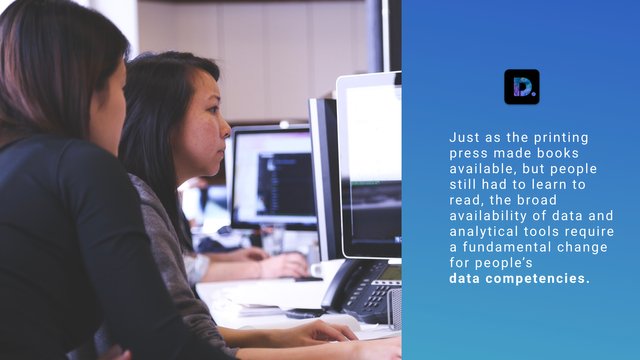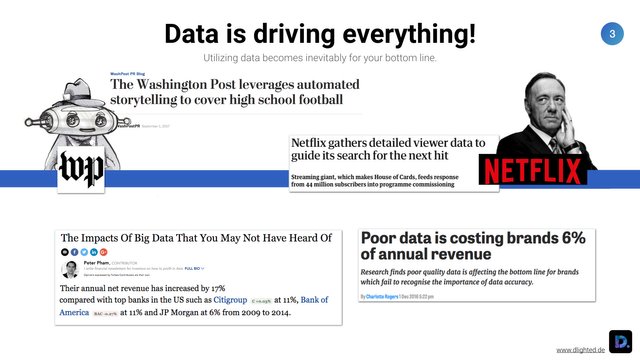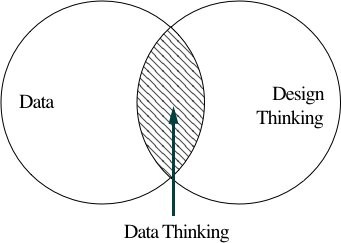WTF is Data Thinking?

Merging Data Science and Design Thinking
Data Thinking: We live in Dataconomy
In 2013, the TV series House of Cards launched on the streaming-service Netflix. It became an international success leading to 2 million new subscribers. Using analytics of viewers' preferences, Netflix's analysts found several trends that ensured them that users would love plot twists, particular characters, and other aspects, even before the show was produced.
In 2016, the Washington Post introduced Heliograf, a prototype of an AI-powered bot. It was able to create automated newspaper articles similar tothe ones written by humans.
In 2018, Google launched Duplex, an AI empowered voice assistant that is able to book appointments in hair salons or restaurants by using speech recognition and text-to-speech synthesis.
Among many others, the three examples illustrate that we were able to experience breakthroughs in many different domains in the last years. We have seen vast advancements in machine and deep learning, speech recognition, natural language processing, and image recognition. While they all facilitate a variety of different interfaces in versatile products and services, they all have something in common: they are all heavily driven by data.

We live in a Dataconomy where data is driving everythingHence, companies need their employees to understand data-driven products and services better. Harris claims that companies need to make sure that their employees are able to read, understand and interpret data. More specifically, employees need to understand how the data strategy is evolving during the different stages of the user journey and the respective product life cycle.
Several studies show that many companies are still facing data challenges to manage the digitization. McAfee et al. argue that these data challenges are related to people and how they interact with technology, including leadership, talent management, and decision-making.
Data Thinking: Start working with data.
However, often it is not necessary to become sophisticated in math.
Data Literacy is more about the "continuous learning journey that creates the ability to identify, understand, interpret, create, communicate, and compute pieces of information to develop knowledge and the ability to participate fully in our society"
says Helena Sternkopf.
Similarly, getting practical with data is often more valuable than revising statistical concepts. Moreover, there is a lack of consistent and appropriate approaches for helping novices learn to 'speak data'. Most of the tools are designed to help users but are not beginner-friendly. Design Thinking is a method that facilitates user-driven innovation processes. However, data innovation has its own particular challenges.
In the last few month, I have been working on bringing these two approaches together. Hence, Data Thinking is bringing Design Thinking and Data Science together. Further, it is a holistic approach to the systematic identification of value-creating data use cases, which improve products and processes through intelligent use of data or form the basis for new, data-based business models.
Data Thinking is the symbiosis of Design Thinking and Data Science.

Formally, it can be defined as
a set of creative strategies that designers utilize during the process of creating new products and services where the working principle is a more detailed view on data at every single design step.
I developed a set of tools during the last few weeks that help people to start working creatively with data, get an overview over the data landscape within their business model, and enable a more inclusive debate between the IT department and product representations. In the next few days I will further introduce the Data Innovation Board - a visual collaboration tool for Data Thinking Workshops.
If you are interested in learning more about the method feel free to follow me here or on my other channels, or say hi in the comments. Moreover, I am happy to answer any questions regarding Data Thinking. Please leave a comment with your thoughts and ideas.
My series of posts is about making you think a little deeper about every day concepts. I look forward to having you follow along and reading what you throw at me. Peace!
Instagram: @tizian_kronsbein
YouTube: Tizian Kronsbein
References
Atchison, S., and J. Burby, "Big data and creativity: What we can learn from 'House of Cards'", The Next Web,2016. https://thenextweb.com/insider/2016/03/20/datainspires-creativity/
Kedhane, J., "A Robot May Have Written This Story", WIRED, 2017.
https://www.wired.com/2017/02/robots-wrote-this-story/
Leviathan, Y., and Y. Matis, "Google Duplex: An AI System for Accomplishing Real-World Tasks Over the Phone", Google AI Blog. http://ai.googleblog.com/2018/05/duplex-ai-system-fornatural-conversation.html
McAfee, A., and E. Brynjolfsson, "Big Data: The Management Revolution", Harvard Business Review, 2012. https://hbr.org/2012/10/big-data-the-managementrevolution
Sternkopf, H., and R.M. Mueller, "Doing Good with Data: Development of a Maturity Model for Data Literacy in Non-governmental Organizations", Proceedings of the 51st Hawaii International Conference on System Sciences (HICSS), IEEE Computer Society (2018), 5045–5054.
Sweney, M., "Netflix gathers detailed viewer data to guide its search for the next hit", The Guardian, 2014. http://www.theguardian.com/media/2014/feb/23/netflixviewer-data-house-of-cards